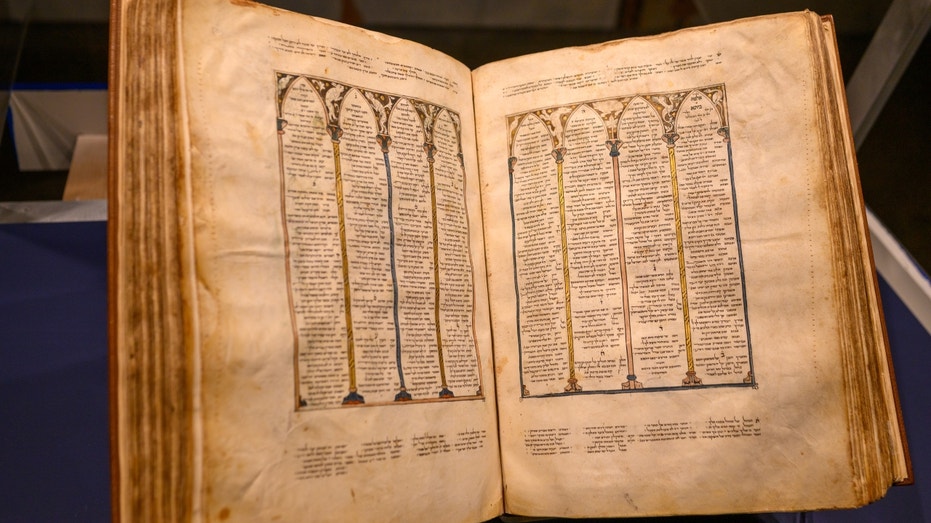Rare Medieval Bible Returns to Israel for Public Exhibition After Centuries-Long Journey
Ancient 14th-century Shem Tov Bible returns to the spotlight as it goes on display at Israel's National Library, a year after its record-breaking sale.

A rare and priceless medieval Hebrew Bible, known as the Shem Tov Bible, has been placed on public display by Israeli officials only a year after its acquisition for a record-setting sum. The National Library of Israel began showcasing this extraordinary manuscript—loaned by its current owner—on May 8, offering visitors a glimpse of a work long celebrated for its remarkable biblical, artistic, Masoretic, and kabbalistic significance.
Dating back to 1312 in medieval Spain, the Shem Tov Bible was created by the renowned Kabbalist rabbi Shem Tov ben Abraham Ibn Gaon. After its completion, the Bible was carried by the rabbi on an arduous two-year journey to what is now Israel, a testament to both the historical and spiritual value imbued in the text from its inception. Rabbi Shem Tov spent the remainder of his life engaged in Jewish scholarship until his death in 1330, while his masterpiece began a centuries-long passage through various cultures and lands.
The manuscript’s odyssey saw it remain in the Middle East before relocating to North Africa in the 17th century, where it became steeped in legend. According to tradition, the Shem Tov Bible was believed to possess mystical powers, often placed with women during childbirth to ensure safe delivery. Such folklore underscores the Bible’s deep cultural resonance across generations and geographies.
Museum-goers are treated to breathtaking illuminations and decorations within the Shem Tov Bible. The manuscript features arcades, gothic arches, depictions of birds and beasts, gilded frames around verses, and elaborate illuminated marginal markers. This synthesis of design reflects interplay between Islamic, Christian, and Jewish artistic influences that flourished in the region at the time, illustrating how Jewish scribes drew upon surrounding visual languages to elevate ritual objects and texts with beauty and meaning.
Sallai Meridor, chairman of the National Library of Israel, described the return of the Shem Tov Bible to Jerusalem as “profoundly significant,” noting, “Having traveled from Spain to Jerusalem, Baghdad, Tripoli, London, and Geneva, the Shem Tov Bible has come full circle and is now back home, returning to the very place where Rabbi Shem Tov ben Abraham Ibn Gaon lived and intended for it to be.”
The Bible was acquired at auction in 2024 for $6.9 million, reflecting its unparalleled significance in the realm of Jewish manuscripts. The Herenstein family, which owns the manuscript, expressed pride in contributing to the preservation and accessibility of such a cultural gem, stating, “We are delighted to know that the Shem Tov Bible is incorporated into the Library’s permanent exhibition… and equally delighted that the manuscript will be digitized to the highest standard, making it available worldwide, for study, research or to simply enjoy its beauty.”
National Library curator Chaim Neria highlighted the scholarly value of the Shem Tov Bible, emphasizing its utility in shedding light on Jewish traditions and textual variants that have nearly disappeared from historical records. A notable feature of the codex is its careful observance of the Sefer Tagei, a traditional guide for sacred scribal practices, and notations referencing earlier, now-lost works such as the Hilleli Codex of 600 CE. These unique elements make the manuscript a vital resource for researchers exploring the evolution of Jewish liturgical texts and customs.
The Shem Tov Bible’s arrival in Israel is part of a wave of recent discoveries and recoveries of major Jewish historical artifacts. Just last year, the Di Gara text—a 16th-century manuscript stolen during the Nazi era—was returned to a Jewish seminary, while earlier this year, archaeologists in Italy uncovered a 1,600-year-old mikveh, believed to be the oldest of its kind in Europe. Each of these finds, along with the public debut of the Shem Tov Bible, serves to deepen appreciation of Jewish history and its enduring contributions to world heritage.




